Research progress on evaluation methods of life test of LED lighting products
Zhang Wei 1,2,3 Hua Shuming 2 Gong Marili 3 Liu Qian 2
(1. Postdoctoral Workstation of Beijing Yiqing Holding Co., Ltd., Beijing 100022, China; 2. National Electric Light Source Quality Supervision and Inspection Center, Beijing 100022, China; 3. Laboratory of Laser and Photonics, Tsinghua University, Beijing 100084, China)
Abstract: Based on the investigation of the life expectancy evaluation of international and national standards for LED lighting products, this paper introduces the current research work on LED life testing and makes an exploratory study on the life evaluation methods of LED lighting products. According to the analysis, there are certain problems in the IESTM21 and boundary function methods using the life test estimation method. Studies have shown that the use of accelerated test conditions to test the life of LED lighting products is highly feasible, and this evaluation method can significantly shorten the life evaluation cycle of the product.
Key words: LED lighting products; life; acceleration; test conditions
CLC number: TM923 Document code: A DOI: 10. 3969/j. issn. 1004-440X. 2013. 01. 010Researching Progress on Lifetime Evaluation Method ofLED Lighting ProductsZhang Wei 1,2,3 Hua Shuming 2 Gong Mali 3 Liu Qian 2 (1. Post-doctor Research Center, Beijing Yiqing Holding Co., Ltd, Beijing 100022, China; 2. National Lighting Test Centre, Beijing 100022, China; 3. Center for Photonics and Electronic, Tsinghua Univesity, Beijing 100084 , China)Abstract: On the basis of the survey research on lifetime evaluation considerations in international and national standards for LED products, current lifetime researching status is analyzed, and the initialexperiment research is performed. According to the analysis and experiment results,there would be someproblems To apply IES TM21 and border function method to evaluate the lifetime of LED lighting products.Our research shows that accelerated experimental conditions would be a reasonable way with high feasibilityto test and evaluate t He lifetime of the overall LED lighting products, and the cycle of lifetime assessmentcould be shorten significantly.
Key words: LED lighting product; lifetime; accelerated;
1 Introduction
Light Emitting Diode (LED) As an optoelectronic device, it has the advantage of long life. With the invention of blue LED chips and the improvement of LED lighting technology, LEDs have gradually entered the field of general lighting, and its technical level has also shown a rapid development trend in recent years. LED lighting products include LED light sources and LED luminaires. For the general lighting field, due to the price factor of LED lighting products, comprehensive consideration of the market should
The cost performance and cost recovery effect, the life of LED lighting products and their evaluation methods have attracted wide attention in the whole industry, and have become a hot topic of recent discussion and research. The research on the life of LED lighting products and its evaluation methods are mainly based on three aspects: (1) Research and implementation of product life assessment methods, which will improve the performance evaluation system of LED lighting products, shorten the test cycle of product comprehensive performance evaluation, and promote (2) The implementation of comprehensive performance evaluation of LED lighting products will provide strong protection for relevant government decision-making and guidance, and promote the development of LED lighting industry from the perspective of government guidance; (3) The work will further enhance the market's normative development, and provide protection for the healthy development of the LED lighting industry from the perspective of consumer perception and application choice. At present, the life assessment of LEDs in the international field is also paying more and more attention. Based on the analysis of LED life assessment methods in the international field, this paper makes a preliminary study on the correspondence between the life evaluation methods of LED lighting products and experimental environmental conditions.
2 LED lighting product life and related research status
2. 1 LED lighting product life
According to the national standard for lighting terminology [1] , the life of a lamp is the total time when the lamp is operated to failure or when it is considered to have failed according to the standard. According to this terminology, the life of a lighting product depends on the relevant regulations and judgments of the way the product fails. Based on this, including international lighting standards, American lighting technical specifications, China's relevant national standards and technical specifications, the life expectancy of LED lighting products and the corresponding failure determination have been considered and explained.
The International Electrotechnical Commission (IEC) is working on the revision of the original IEC/TS 62504 LED Terms and Definitions technical documents. The revised standards will harmonize the definitions of terms related to the various IEC standards related to LED lighting. The revised IEC62504 standard will be significantly different from the original TS version. The IEC62504 standard [2] will give a definition of the life of a product from the perspective of lumen maintenance of LED lighting products. According to this life definition, the life of an LED lighting product is determined by the change in the lumen maintenance rate of the product as the ignition time increases. When the lumen maintenance rate of the product is attenuated to a specified value (usually set to 70 depending on the application site) The cumulative ignition time of % or 50%) is the life of the product.
The product's light output and light maintenance are important factors in the life expectancy of LED lighting products. In addition, from the consideration of LED lighting product characteristics and application sites, there are certain differences in product life evaluation indicators. For example, in addition to the lumen maintenance rate, the color quality and maintenance of LED lighting products, etc. Research work in this area [3] is carried out to make a more reasonable assessment of the performance and life of LED lighting products. Table 1 also gives considerations for relevant countries or regions in terms of LED lighting product life related indicators.
For the consideration of life-related indicators of LED lighting products, the standard or technical documents in Table 1 are considered from the parameters such as lumen maintenance rate LM, color coordinate drift, life time specification and failure rate. The parameters such as lumen maintenance rate and color drift of LED lighting products in the above standards or technical documents are specified in kh (thousands of hours). There is no validated and practical accelerated test or evaluation method. . China has launched LED lighting products energy-saving certification [8 ~ 11] , there are similar problems in the test items such as product lumen maintenance.
2. 2 Summary of LED Life Test Calculation Methods
2. 2. 1 US IES TM21 [12] standard for the calculation of LED lumen maintenance
In 2011, the United States released the IES TM21 "Projecting Long Term Lumen Maintenance of LED Light Sources" standard for LED modules for LED packaging, LED arrays, and external drive control. The standard specifies a method for estimating the lumen maintenance of LED sources using exponential decay as a luminous flux attenuation model using IES LM80 test data, as shown in Figure 1.
The specific operation method is as follows.
1 Test the luminous flux at intervals of not more than 1000h, and the test time is not less than 6000h;
2 Calculate the luminous flux maintenance rate at each time point based on the 0h luminous flux;
3 Fit the exponential decay model φ (t) = β·exp ( - αt) to fit the lumen maintenance rate trend curve. If the total test time does not exceed 10000h, take the last 5000h data point as the fitting curve raw data; if the total test time If it exceeds 10000h, the last 50% of the total test time is the original curve of the fitting curve;
4 Calculate the α and β values ​​based on the curve fitting results, and calculate the L 70 lifetime of the light source based on L 70 = ln (β/0. 7) /α (if the estimated life time is greater than the total test time of 5.7) In times (or 6 times), take 5. 5 times (or 6 times) of the total test time to estimate the life time).
Table 1 International standards for LED lighting products or documents on life-related indicators
Table 1 Lifetime related performance index regulation in the standards or technical specifications 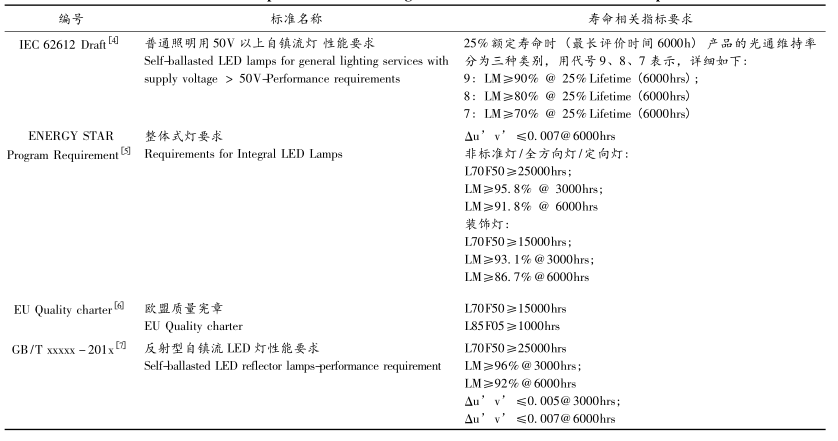
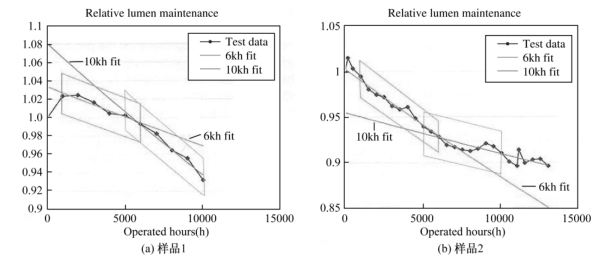
figure 1
IES TM21 Example of LED lumen maintenance rate estimation*
* Quote IES TM21 Figure A1 and A2Fig. 1 Example of lumen maintenance projecting in IES TM21
2. 2. 2 LED life estimation method based on boundary function
Based on the discussion of IES TM21 on LED life estimation method in IEC standard technical discussion, some experts have raised the question of TM21 in LED universality, and proposed the LED life estimation method based on boundary function. The method compares the luminous flux maintenance test curve of the LED package with the exponential decay boundary function, and defines the life time corresponding to the applicable boundary function as the life of the LED package, as shown in FIG. 2 .
The specific operation method is as follows.
1 Test the luminous flux of the LED package at 0h, 500h, 1000h, 2000h, 3000h, ... for the time interval, the total test time should not be less than 6000h;
2 Calculate the luminous flux maintenance rate at each time point and plot the luminous flux maintenance rate based on the 0h luminous flux;
3 On the above luminous flux maintenance rate graph, plot the B (t) = e - αt exponential decay boundary function curve, and the parameters in the curve are calculated according to B (L 70 ) =0. 7;
4 If the last 2000h lumen maintenance rate on the lumen maintenance rate graph is higher than the boundary function curve, the lifetime of the LED package is greater than the L 70 lifetime value corresponding to the boundary function.
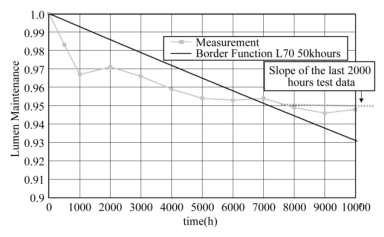
Figure 2 Example of LED package life estimation based on boundary function
Fig. 2 Example of LED lifetime prediction based on border function
2. 2. 3 IEC proposal for LED life test
During the development of the IEC international standard, some members proposed the luminous flux maintenance rate test and speculation for LED devices in 2010 [13], and proposed the calculation method of the luminous flux maintenance rate of LED devices based on temperature acceleration comparison. As shown in Figure 3.
The calculation method of the luminous flux maintenance rate is:
1 Perform sample lumen maintenance ignition test at at least two shell temperatures;
2 Test the luminous flux of the LED device at 0h, 500h, 1000h, 2000h, 3000h, ... respectively, and calculate the lumen maintenance rate at each time point, the test time is not less than 6000h;
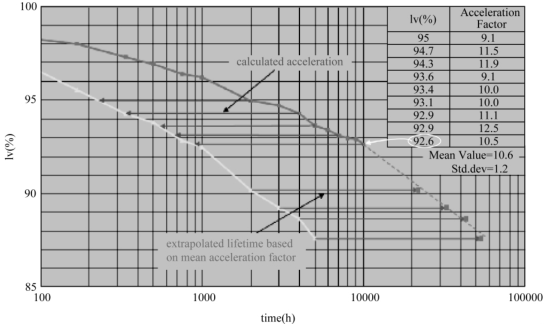
Figure 3 Example of estimating the luminous flux maintenance rate based on temperature acceleration comparison
Fig. 3 Example of LED lifetime prediction based on temperature acceleration
3 Connect the lumen maintenance test points at each temperature;
4 Connect the points of the same lumen maintenance level on the lumen maintenance curve at two different temperatures;
5 Calculate the acceleration factor by the time corresponding to the above connection point;
6 Repeat 45 operations for at least 5 different lumen maintenance levels, and the time interval between points should not be less than 500h;
7 Calculate the average acceleration factor;
8 Use the average acceleration factor to estimate the lumen maintenance at low temperatures as a function of the ignition time based on the high temperature test curve.
Comparative analysis and research 3 LED life test Calculation Method
The relevant important factors for the LED life estimation methods in the above three international scopes are shown in Table 2.
Table 2 Important factors for three LED life estimation methods
Table 2 Characteristics of the three kinds of LED lifetime projecting (prediction) method

3. 1 IES TM21 About LED Life Estimation Method
The IES TM21 LED life estimation method is based on the IES LM80 test data on LED lumen maintenance. Figure 4 shows a plot of lumen maintenance retention for a model of LED device LM80 using the IES TM21 lifetime estimation method.

Figure 4 IES TM21 fitting results based on IES LM80 lumen maintenance test data
Fig.4 IES TM21 LED lifetime projecting based on IES LM80 test results
According to the curve fitting results, the LED life indicators under three kinds of ignition temperature are ranked as the LED life under the LED life >105 °C at 85 °C >55 °C, which is not consistent with the actual situation, therefore, the life of IES TM21 The calculation method needs further research to confirm the applicability.
3. 2 LED device life estimation method based on exponential decay boundary function
This method confirms the minimum life indicator of the LED after the 2000h lumen maintenance rate test result and the corresponding time point maintenance rate value on the boundary function. The LED products were collected for 6000h lumen maintenance test and fitted according to the exponential decay boundary function. The results are shown in Figure 5.
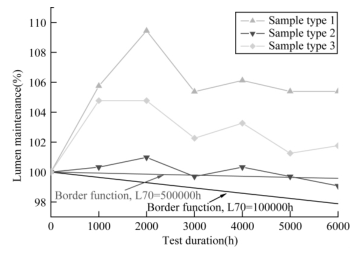
Figure 5 Comparison of the luminous flux maintenance curve and boundary function of three LED products
Fig. 5 Comparison between border function and lumenmaintenance test results of three LED product samples
Figure 5 shows the boundary function curves for the lifetimes of 100000h and 500000h. Comparing the luminous flux maintenance test curves of the three LED products, the lifespan of the three products is higher than 100000h, and the lifespan of products 1 and 3 is More than 500000h, there is a large non-compliance with product life. Therefore, the boundary function comparison method is not suitable for the life prediction of LED lighting products.
3. 3 LED life estimation method and research based on temperature acceleration comparison
The method accelerates stress with temperature as the life, and the test time at low temperature should not be lower than 6000h. Based on this life estimation method, the experimental study on the relationship between test conditions and life parameters of LED lighting products was carried out.
3. 3. 1 test plan
During the life ignition process, due to the performance changes of LED devices, lenses, drives and other components or the heat dissipation effect of the products, the attenuation of the life parameters of LED lighting products is mainly reflected in the two aspects of luminous flux attenuation and color drift. Considering the interaction between product components, the life evaluation test method for LED lighting products takes the overall LED lighting products as the research object, so the test conditions are set to consider the practical test operation feasibility for the whole product.
In this stage, the ignition temperature is used as the test stress, different temperature levels are set, and the lamp is tested for ignition at the temperature control environment temperature (± 2 °C). The integrated ball-spectral radiance meter is used to monitor the system during the long-term ignition process. Changes in the life parameters of LED lighting products at various temperature levels. The setting of the temperature level and the analysis of the sample state during the test are important considerations for the test.
First, test samples were collected to monitor the temperature of the lamp components at different ignition temperatures to determine the limit level of the temperature stress test. The test results are shown in Figure 6.
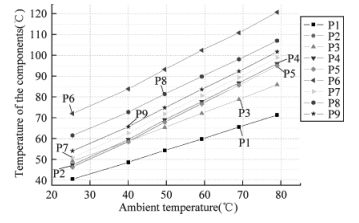
Figure 6 Temperature monitoring test results of various parts in the lamp at different ignition temperature
Fig. 6 Temperature monitoring results of the LED lamp componentsunder different ambient temperature
Combined with the performance of each component of the LED lighting product, the temperature monitoring results shown in Figure 7 are analyzed to determine the upper limit of the temperature stress test, and then set the ambient temperature level of each ignition point.
3. 3. 2 Experimental results
Collect representative LED lighting products and test the ignition and light color parameters at different ambient temperature levels. Figure 7 shows the corresponding test results.

Figure 7 Comparison of LED product ignition test results at different ambient temperatures
Fig. 7 Lumen maintenance test results of the LED product underdifferent ambient temperature environment
The lower test curve in Figure 7 is the test result of the ignition test at high ambient temperature level, and the upper curve is the comparison test result under the normal life ignition test temperature. It can be seen that the luminous flux maintenance rate of the product shows a rapid decay trend at high ignition temperature. By 1968h, the luminous flux attenuation of the sample reached 58.2%, which indicates that the test method with ambient temperature as the acceleration test factor has certain feasibility. In order to further analyze the factors affecting the attenuation of the sample in the high ambient temperature, the sample after the test is disassembled and analyzed to test the luminous flux attenuation caused by the burning process of each component. The test results show that the LED package is caused by the ignition process. The luminous flux attenuation is 57.9%, which is basically equivalent to the luminous flux attenuation value of the sample. That is to say, with the ambient temperature as the accelerated stress, the product does not exhibit abnormal life parameter index change or failure mode under the condition of rapid decay of luminous flux, that is, the life test evaluation time of the LED product is not the product under the normal low temperature environment temperature. The lumen maintenance test and the relatively consistent acceleration factor at different maintenance rates are necessary, and the product life test evaluation time can be reduced without changing the product failure mode.
4 Conclusion
Based on the comparative study of existing LED related life test methods, the research on the life test evaluation method of LED lighting products is carried out. The experimental study on the ignition point ambient temperature as the accelerated stress shows that for the temperature performance characteristics of the LED lighting products, the product life evaluation parameter index has a significant acceleration effect at a certain temperature level. At the same time, the luminous flux attenuation factor and failure mode of the product It has not changed, therefore, the ignition ambient temperature can be studied in depth as an effective accelerated life of LED lighting products.
At this stage of the test, only a single stress is considered. In order to further study and improve the life test method of LED lighting products, further research is needed on the aspects of test stress, sample representativeness, component characteristics, and comprehensive life evaluation parameters.
★ On January 19, 2013, the United Nations adopted a mercury treaty that aims to effectively prevent mercury emissions and releases in many areas, including electric light sources, in the form of legal instruments worldwide. This is the result of many negotiations with all relevant UN member states after more than two years of efforts in the global lighting industry represented by the European Lighting Association (ELC). The final negotiation results are in full compliance with the Global Light Association Association (GLA) and are generally not more stringent than the requirements of the European RoHS Directive. The Convention will be implemented between 2018 and 2020.
references
[1] GB/T 2900. 65 -2004 Electrotechnical terminology. National Standard of the People's Republic of China: 2004. 845 -07 -61.
[2] IEC 62504: General lighting-Light emitting diode (LED) products and related equipment-Terms and definitions (Draft). International Electrotechnical Commission draft standard: 2012.
[3] Zhang Wei, Xu Haihan, Hua Shuming. Study on the Stability of LED Color and Light Parameters. Solid State Lighting, 2011, 3 (9): PP39 ~ 42.
[4] IEC 62612 Self-ballasted LED lamps for general lighting services with supply voltages > 50V-Performancerequirements[Draft]. International Electrotechnical Commission draft standard: 2012.
[5] ENERGY STAR Program Requirements for Integral LEDLamps. US Energy Star Program Requirements.
[6] EUROPEAN LED QUALITY CHARTER. European Union Quality Charter.
[7] GB/T xxxxx -201x Reflective self-ballasted LED lamp performance requirements [reported draft]. National Standard of the People's Republic of China.
[8] CQC3127 - 2010 LED Road/Tunnel Lighting Product Energy Conservation Certification Technical Specification. China Quality Certification Center Semiconductor Lighting Product Energy Conservation Certification Technical Specification.
[9] CQC3128 -2010 LED downlight energy-saving certification technical specifications. China Quality Certification Center semiconductor lighting products energy-saving certification technical specifications.
[10] CQC3129 -2010 Reflective self-ballasted LED lamp energy-saving certification technical specifications. China Quality Certification Center semiconductor lighting products energy-saving certification technical specifications.
[11] CQC3130 -2011 Non-directional self-ballasted LED lamp energy-saving certification technical specifications for general lighting. China Quality Certification Center semiconductor lighting products energy-saving certification technical specifications.
[12] IEC/PAS 6xxxx - LED Testing and prediction of lumenmaintenance. International Electrotechnical Commission standard proposal.
High efficient charging speed for Toshiba laptop, stable current outlet can offer power for the laptop at the same time charge the laptop battery. The best choice for your replacement adapter. We can meet your specific requirement of the products, like label design. The plug type is US/UK/AU/EU. The material of this product is PC+ABS. All condition of our product is 100% brand new.
Our products built with input/output overvoltage protection, input/output overcurrent protection, over temperature protection, over power protection and short circuit protection. You can send more details of this product, so that we can offer best service to you!
Toshiba Adapter,Adapter For Toshiba,Power Supply For Toshiba,Laptop Charger For Toshiba
Shenzhen Waweis Technology Co., Ltd. , https://www.huaweishiadapter.com